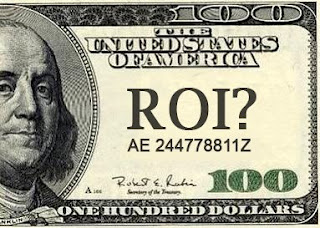
As a real estate investor if you’re going to take on the risk of owning property, you need to have a shot at getting a very nice return. Most people getting into real estate usually have enough extra cash for one additional acquisition. Therefore, if you’re going to tie up a bunch of your cash in an investment property, you better be getting a solid return. Enough of a return so that if something goes wrong, you can still get by with a lesser return.
For real estate investors it is always a good idea in dealing with investment properties that can produce at least a 10 percent return on your investment. Of course, when you factor in financing on a property it changes the numbers in your favor as the leverage you get from borrowing is enough to dramatically increase your return. Many investors like to use the 10% approach as a rule of thumb on an all cash acquisition. This more conservative approach helps take the emotion out of the decision to buy. If the numbers add up, then you are more inclined to move forward on an acquisition. If not, then it’s easy to eliminate the property and move on. Many investors however have trouble locating true 10% properties as these types of properties can be hard to find.
When you are looking to purchase income property be it residential or commercial you have to comfortable with terms like CAP Rate & ROI. These numbers can be very helpful If you understand exactly what they mean and what constitutes a “good” rate of return. To help accurately evaluate potential investment properties it is important to start with a working knowledge of a couple of main formulas used to evaluate potential real estate investments.
First is the CAP Rate or Capitalization Rate. You will probably see this formula used more than any other when describing the investment potential for a particular piece of real estate. The CAP rate is determined by dividing the Net Annual Operating Income by the Acquisition Cost of the property. Net Annual Operating Income is defined as the total of rents collected in a year minus all expenses associated with owning the property. These expenses may include: property taxes, HOA dues, any utilities paid by the owner, vacancy allowance, repairs/maintenance allowance, property management, and property insurance.
Acquisition Cost is defined as the total cost necessary to purchase the property, so think purchase price plus all closing costs, title and escrow fees, etc. Using the above formula, if you acquired a property for $500,000 and the Net Annual Operating Income of the Property was $50,000, then you would have a property with a CAP Rate of 10%. A 10% CAP rate is often referenced as a goal to shoot for. In general, most areas of the country will have CAP rates in the range of 8-12% for cash flowing residential single family homes and commercial multi family apartment buildings.
The second type of return discussed with regards to income properties and the better way to evaluate potential investment properties is by calculating Return on Investment or ROI. The ROI will show you what your return is on the money that you have actually put into the project. What you have to understand is that If you paid cash for your investment property, then your ROI and your CAP rate will be identical. If, however, you purchased a property using any debt, then your ROI will be the NET Annual Operating Income of the property divided by your initial equity investment (cash in the form of down payment, any out-of-pocket closing costs, etc.)
Using this formula, we can see that if we purchased the same property as above and put 20% down ($100,000) then your ROI would be $50,000 divided by $100,000 = 50% ROI. The beauty of using financing for your investment acquisitions is it allows you to leverage yourself into a much higher rate of return for your money than all cash purchases.
As long as you are purchasing properties that have positive cash flow, after all mortgage notes and other expenses are paid, it is always better to purchase using financing in order to maximize your rate of return. The important thing to remember when shopping for investment properties is that good deals need to be thoroughly vetted. You should always ask for a detailed pro forma or create your own for any investment property that you are considering purchasing. Keep in mind that not all pro forma’s are created equal and sellers projected CAP Rate or ROI can vary widely based on how detailed expenses are. Taking a conservative approach to expenses on your pro forma will help ensure that you find the best investment properties for your investment dollars.
The Buyers Utopia network is currently offering our investor clients turnkey residential investment properties in numerous markets that are performing at a 10 CAP. For those looking for cash flow positive investment properties contact us about our vetted income properties. Properties are acquired via short sales and at the foreclosure auctions, then renovated to move-in condition, placing renters in them and selling them to investor clients as turn-key investment opportunities with CAP rates that are 10% or higher. If you are interested in this type of investment opportunity Call 312.433.9300 x 20. We have residential opportunities in numerous markets around the country Chicago, Indianapolis, Memphis, Atlanta, Phoenix & Dallas.
[iphorm_popup id=3 name=”Residential Cash Flow Positive Income Properties”]Learn about our renovated and managed residential income properties receiving 10% Cash on Cash Returns[/iphorm_popup]
Leave a Reply
You must be logged in to post a comment.